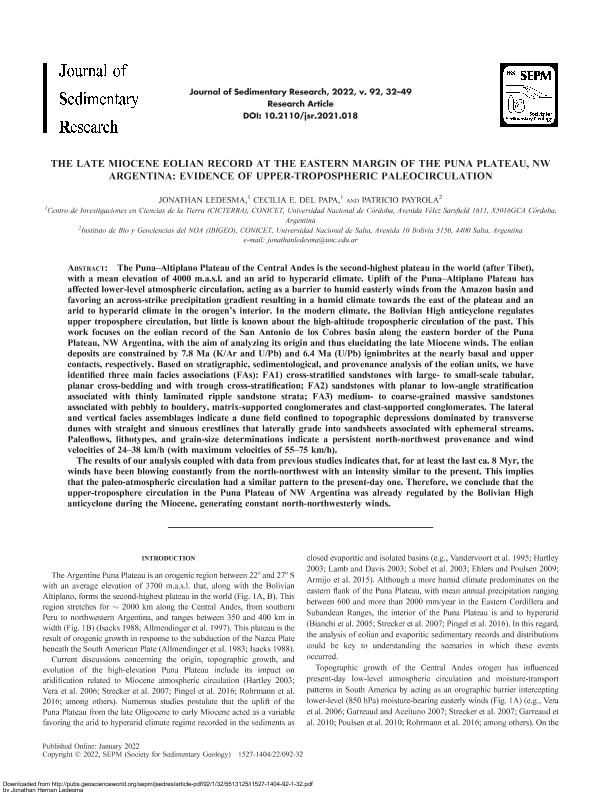Mostrar el registro sencillo del ítem
dc.contributor.author
Ledesma, Jonathan Hernán

dc.contributor.author
del Papa, Cecilia Eugenia

dc.contributor.author
Payrola Bosio, Patricio Augusto

dc.date.available
2023-07-27T14:14:23Z
dc.date.issued
2022-01
dc.identifier.citation
Ledesma, Jonathan Hernán; del Papa, Cecilia Eugenia; Payrola Bosio, Patricio Augusto; The late Miocene eolian record at the eastern margin of the Puna Plateau, NW Argentina: Evidence of upper-tropospheric paleocirculation; Society for Sedimentary Geology; Journal of Sedimentary Research - (Print); 92; 1; 1-2022; 32-49
dc.identifier.issn
1527-1404
dc.identifier.uri
http://hdl.handle.net/11336/205817
dc.description.abstract
The Puna–Altiplano Plateau of the Central Andes is the second-highest plateau in the world (after Tibet), with a mean elevation of 4000 m.a.s.l. and an arid to hyperarid climate. Uplift of the Puna–Altiplano Plateau has affected lower-level atmospheric circulation, acting as a barrier to humid easterly winds from the Amazon basin and favoring an across-strike precipitation gradient resulting in a humid climate towards the east of the plateau and an arid to hyperarid climate in the orogen’s interior. In the modern climate, the Bolivian High anticyclone regulates upper troposphere circulation, but little is known about the high-altitude tropospheric circulation of the past. This work focuses on the eolian record of the San Antonio de los Cobres basin along the eastern border of the Puna Plateau, NW Argentina, with the aim of analyzing its origin and thus elucidating the late Miocene winds. The eolian deposits are constrained by 7.8 Ma (K/Ar and U/Pb) and 6.4 Ma (U/Pb) ignimbrites at the nearly basal and upper contacts, respectively. Based on stratigraphic, sedimentological, and provenance analysis of the eolian units, we have identified three main facies associations (FAs): FA1) cross-stratified sandstones with large- to small-scale tabular, planar cross-bedding and with trough cross-stratification; FA2) sandstones with planar to low-angle stratification associated with thinly laminated ripple sandstone strata; FA3) medium- to coarse-grained massive sandstones associated with pebbly to bouldery, matrix-supported conglomerates and clast-supported conglomerates. The lateral and vertical facies assemblages indicate a dune field confined to topographic depressions dominated by transverse dunes with straight and sinuous crestlines that laterally grade into sandsheets associated with ephemeral streams. Paleoflows, lithotypes, and grain-size determinations indicate a persistent north-northwest provenance and wind velocities of 24–38 km/h (with maximum velocities of 55–75 km/h). The results of our analysis coupled with data from previous studies indicates that, for at least the last ca. 8 Myr, the winds have been blowing constantly from the north-northwest with an intensity similar to the present. This implies that the paleo-atmospheric circulation had a similar pattern to the present-day one. Therefore, we conclude that the upper-troposphere circulation in the Puna Plateau of NW Argentina was already regulated by the Bolivian High anticyclone during the Miocene, generating constant north-northwesterly winds.
dc.format
application/pdf
dc.language.iso
eng
dc.publisher
Society for Sedimentary Geology

dc.rights
info:eu-repo/semantics/openAccess
dc.rights.uri
https://creativecommons.org/licenses/by-nc-sa/2.5/ar/
dc.subject
Eolian sedimentation
dc.subject
Miocene
dc.subject
Puna-Altiplano
dc.subject
Bolivian High
dc.subject.classification
Geología

dc.subject.classification
Ciencias de la Tierra y relacionadas con el Medio Ambiente

dc.subject.classification
CIENCIAS NATURALES Y EXACTAS

dc.title
The late Miocene eolian record at the eastern margin of the Puna Plateau, NW Argentina: Evidence of upper-tropospheric paleocirculation
dc.type
info:eu-repo/semantics/article
dc.type
info:ar-repo/semantics/artículo
dc.type
info:eu-repo/semantics/publishedVersion
dc.date.updated
2023-07-06T22:03:07Z
dc.journal.volume
92
dc.journal.number
1
dc.journal.pagination
32-49
dc.journal.pais
Estados Unidos

dc.journal.ciudad
Lawrence
dc.description.fil
Fil: Ledesma, Jonathan Hernán. Consejo Nacional de Investigaciones Científicas y Técnicas. Centro Científico Tecnológico Conicet - Córdoba. Centro de Investigaciones en Ciencias de la Tierra. Universidad Nacional de Córdoba. Facultad de Ciencias Exactas Físicas y Naturales. Centro de Investigaciones en Ciencias de la Tierra; Argentina
dc.description.fil
Fil: del Papa, Cecilia Eugenia. Consejo Nacional de Investigaciones Científicas y Técnicas. Centro Científico Tecnológico Conicet - Córdoba. Centro de Investigaciones en Ciencias de la Tierra. Universidad Nacional de Córdoba. Facultad de Ciencias Exactas Físicas y Naturales. Centro de Investigaciones en Ciencias de la Tierra; Argentina
dc.description.fil
Fil: Payrola Bosio, Patricio Augusto. Consejo Nacional de Investigaciones Científicas y Técnicas. Centro Científico Tecnológico Conicet - Salta-Jujuy. Instituto de Bio y Geociencias del Noroeste Argentino. Universidad Nacional de Salta. Facultad de Ciencias Naturales. Instituto de Bio y Geociencias del Noroeste Argentino; Argentina. Universidad Nacional de Salta. Facultad de Ciencias Naturales. Escuela de Geología; Argentina
dc.journal.title
Journal of Sedimentary Research - (Print)

dc.relation.alternativeid
info:eu-repo/semantics/altIdentifier/url/https://pubs.geoscienceworld.org/jsedres/article/92/1/32/610805/The-late-Miocene-eolian-record-at-the-eastern
dc.relation.alternativeid
info:eu-repo/semantics/altIdentifier/doi/http://dx.doi.org/10.2110/jsr.2021.018
Archivos asociados
